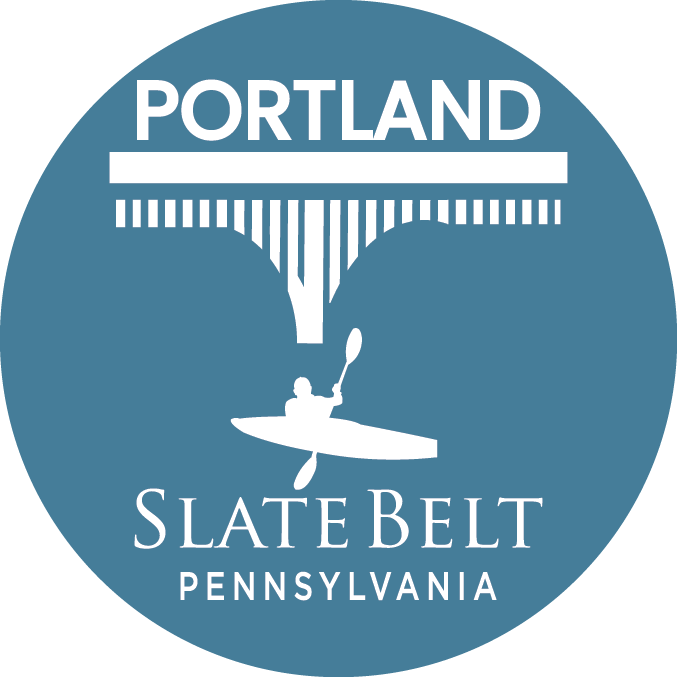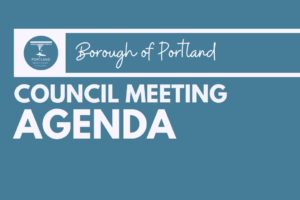Records indicate that Francis Myerhoff, owner of the Columbia Glass Works, received a charter from the State of New Jersey to build a bridge across the river to help in the delivery of the sand he needed for his factory in New Jersey. Early in January, 1869, the bridge was finally completed by the Charles, Kellogg and Maurice Company of Athens, Pennsylvania (later the Union Bridge Company) for the cost of about $40,000. The original structure was a Burr truss, four-span Timber Bridge with wooden arches which was covered by a wooden shed with a slate roof. The bridge was 775 feet long and 18 feet wide and was primarily used in the early days for the movement of livestock from New Jersey to the Portland rail yards. No more than 15 head of cattle or 15 sheep or pigs were permitted to cross at one time, any running or uncontrollable behavior could cause the bridge to sway dangerously. A man or boy walked in front of the herd and another brought up the rear, forcing the animals to walk spaced as evenly as possible. A story recounted by Charles Newbaker, Sr., a bridge guard, was one of the more interesting examples of livestock incidents when a circus crossed the bridge. The elephant came to the entrance, backed off, and swam across the river!
The arrival of the automobile increased travel to such a degree that the bridge was deemed a “gold mine.” Beginning about 1917, the toll was collected by Charles Newbaker and rates were: 20 cents one way and 35 cents round trip for a coupe auto, 25 cents one way and 40 cents round trip for touring cars, and 2 cents each way for pedestrians and horseback riders. For the farmer driving animals across the bridge the fare was: 20 cents one way and 40 cents round trip for a double team. Wheelbarrows and express wagons were charged 4 cents each way. A man, wife and family crossed for 50 cents a month, while storekeepers and coalmen passed for 20 cents a round trip. The only thing that crossed the bridge free was a baby carriage.
During its day of private ownership, the space on the sides of the bridge were sold to commercial companies for advertising and upkeep purposes. In 1903, the ad “Pure and Harmless Sozodont for the Teeth and Breath” graced the sides of the bridge. This sign was believed to be the largest in the United States at the time. In 1917, the famous red Coca Cola ad was also painted on the bridge. In November, 1926, it was agreed to sell the structure to The Joint Commission for the Elimination of Toll Bridges for $50,000. M.M. Heller, who was the largest stockholder as well as the oldest director, was given the honor of determining when the collecting of toll should cease. He chose noon on Wednesday, June 15, 1927 so at 11:59 a.m., a car with the Pennsylvania License No. 213688, paid the last toll on the bridge. Mr. Newbaker painted “FREE BRIDGE” signs and placed them near the bridge entrances.
It remained open to automobiles traffic until November 30, 1953 when the Delaware River Joint Toll Bridge Commission, owners of the bridge, closed it to all but pedestrians. The automobile traffic was shifted to the new Portland-Columbia Toll Bridge, built one-quarter mile downstream of the old bridge.
The covered bridge withstood a number of storms and floods for almost 100 years but on August 19, 1955, during the remnants of Hurricane Diane, three of the four spans of the timber bridge washed away. Residents watched in horror as animals, house and debris began to float down the river as the water began to rise. The covered bridge could not withstand the force of the river, once the current began to press against the wooden sides. Hurricane Diane was the wettest hurricane to ever hit the North American continent and caused record flooding throughout the northeastern US, but particularly the Delaware River watershed. A couple miles downstream from the covered bridge, a steel railroad bridge also spanned the Delaware, and still does today. It is thought that the Portland side of the bridge let go first, followed by the Columbia side and the first side got hung up at the steel bridge, then the second side joined it like a big V. Unfortunately, that was the end of the longest covered bridge in the United States and the last one spanning the Delaware River.
Today, the pedestrian bridge is built on the original piers, making it possible to walk from Portland, Pa., to Columbia, N.J., across the Delaware River. It is the beginning of the Liberty Trailand ends at Liberty state park in Jersey City and is a part of the September 11th National Memorial Trail, a 1,300-mile commemorative trail linking the National September 11 Memorial in New York City, the Pentagon Memorial and the Flight 93 Memorial in Shanksville, PA. Many tourists and residents find the bridge a beautiful spot to take photographs and observe area wildlife. It is also the perfect spot for rafters to end a tubing trip to enjoy the various antique shops and history the town of Portlandhas to offer….or even for a little geocaching!
The Delaware River provided easy transport. At first only the Indians skimmed their canoes over its surface, but by the mid-18th century, rafts were in use during spring floods. As late as 1870, the river near Portland would be full of rafts as far was the eye could see. Rafting started to wane in the 1880s because railroads had reached the lumbering country. The Portland Covered Bridge had its beginnings as early as February 5, 1816. Records indicate that Francis Myerhoff, owner of the Columbia Glass Works, received a charter from the State of New Jersey to build a bridge across the river to help in the delivery of the sand he needed for his factory in New Jersey. In January 1869, the bridge was finally completed by the Charles, Kellogg and Maurice Company of Athens, Pennsylvania, which was later renamed the Union Bridge Company. According to an Easton paper of January 19, 1869, Mrs. Sophia Sandt rode from Pennsylvania to New Jersey and back again in her sleigh “amidst the applause of the people.” The bridge, of the Burr Truss type, was 775 feet long, 18 feet wide, and cost about $40,000 to construct.
The four-span wooden bridge was destroyed in the historic Delaware River flood of 1955. At that time, it was the longest remaining wooden covered bridge in the United States. The current steel pedestrian bridge was installed atop the wooden bridge’s reconstructed piers and abutments in 1957-58.

























